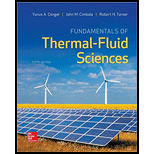
Concept explainers
(a)
The mass flow rate of ethylene glycol.
(a)
Explanation of Solution
Given:
The temperature
The initial temperature
The exit temperature
The dimensions
The length
The outer diameter
The mass flow rate
The heat transfer coefficient
The exit temperature
The properties of ethylene glycol are:
Calculation:
Calculate the bulk mean temperature
Refer table
Obtain the following properties of oil corresponding to the temperature of
Calculate the mass flow rate
Thus, the mass flow rate of ethylene glycol is
(b)
The number of tube rows.
(b)
Explanation of Solution
Given:
Calculation:
Calculate the maximum velocity
Calculate the Reynolds number
Calculate the Nusselt number
Assume that the tube rows are greater than
Thus, from table
Calculate the heat transfer coefficient
Calculate the overall heat transfer coefficient
Calculate the heat capacity rate
Calculate the heat capacity rate
Calculate the capacity ratio
Calculate the effectiveness
Calculate the
Refer table
Calculate the surface area
Calculate the number of rows
Thus, the number of rows are
Want to see more full solutions like this?
Chapter 22 Solutions
Fundamentals of Thermal-Fluid Sciences
 Elements Of ElectromagneticsMechanical EngineeringISBN:9780190698614Author:Sadiku, Matthew N. O.Publisher:Oxford University Press
Elements Of ElectromagneticsMechanical EngineeringISBN:9780190698614Author:Sadiku, Matthew N. O.Publisher:Oxford University Press Mechanics of Materials (10th Edition)Mechanical EngineeringISBN:9780134319650Author:Russell C. HibbelerPublisher:PEARSON
Mechanics of Materials (10th Edition)Mechanical EngineeringISBN:9780134319650Author:Russell C. HibbelerPublisher:PEARSON Thermodynamics: An Engineering ApproachMechanical EngineeringISBN:9781259822674Author:Yunus A. Cengel Dr., Michael A. BolesPublisher:McGraw-Hill Education
Thermodynamics: An Engineering ApproachMechanical EngineeringISBN:9781259822674Author:Yunus A. Cengel Dr., Michael A. BolesPublisher:McGraw-Hill Education Control Systems EngineeringMechanical EngineeringISBN:9781118170519Author:Norman S. NisePublisher:WILEY
Control Systems EngineeringMechanical EngineeringISBN:9781118170519Author:Norman S. NisePublisher:WILEY Mechanics of Materials (MindTap Course List)Mechanical EngineeringISBN:9781337093347Author:Barry J. Goodno, James M. GerePublisher:Cengage Learning
Mechanics of Materials (MindTap Course List)Mechanical EngineeringISBN:9781337093347Author:Barry J. Goodno, James M. GerePublisher:Cengage Learning Engineering Mechanics: StaticsMechanical EngineeringISBN:9781118807330Author:James L. Meriam, L. G. Kraige, J. N. BoltonPublisher:WILEY
Engineering Mechanics: StaticsMechanical EngineeringISBN:9781118807330Author:James L. Meriam, L. G. Kraige, J. N. BoltonPublisher:WILEY





